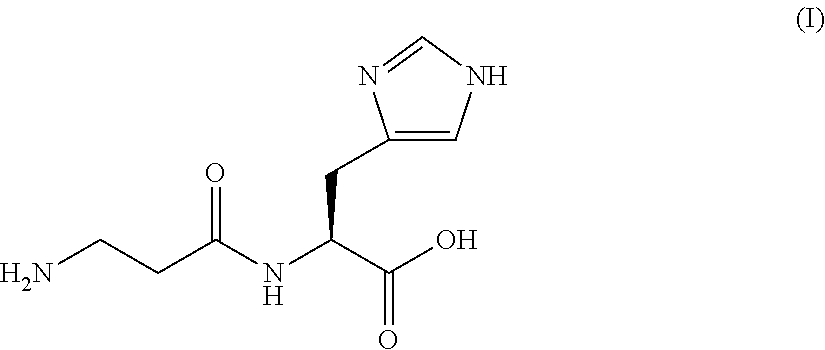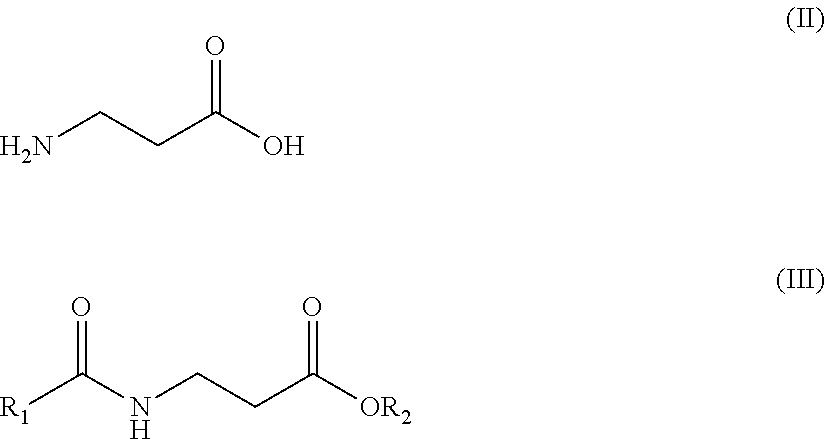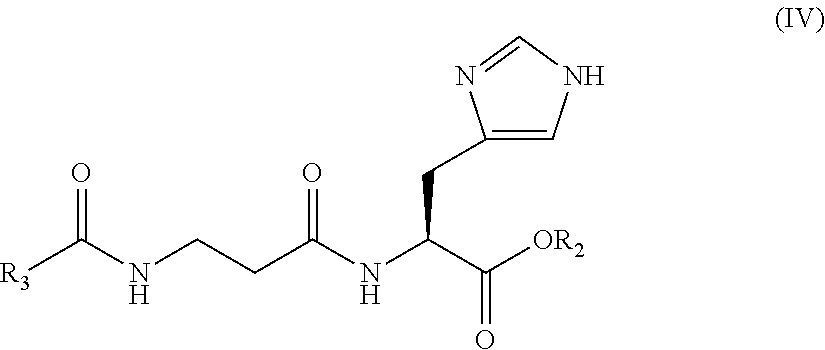Combined use of a carnosinase inhibitor with l-carnosine or its related substance and a composition containing the same
- Summary
- Abstract
- Description
- Claims
- Application Information
AI Technical Summary
Benefits of technology
Problems solved by technology
Method used
Image
Examples
example 1
Hydrolysis of L-Carnosine and Related Substance with a Tissue Carnosinase in the Absence or the Presence of a Carnosinase Inhibitor.
[0102]Materials and Methods:
[0103]Partially purified tissue carnosinase as a solution in 0.1 M phosphate buffer (pH7.0) is prepared from the crude brain extracts of male Hairless rats by a reported procedure (Y. Courbebaisse, G. Langrand, J-F. Nicolay and M. A. Babizhayev, Proceeding of 19th IFSCC Congress, Australia, Vol. 3, 1996, p. 1-12; M. A. Babizhayev et al., Letters in Peptide Science, Vol. 5, 163, 1998). A solution of the substrate (450 μl ) in 0.1 M phosphate buffer (pH7.0) is incubated with the diluted enzyme solution (50 μl ) at 37° C. for 120min. in the absence or in the presence of a carnosinase inhibitor. Portions of the reaction mixture are taken at the time points of 0, 2, 3, 4, 5, 10, 20, 40, 60 min and dansylated with dansyl chloride (5 mg of dansyl chloride / ml of acetonitrile solution) at 50° C. for 15min. The each portion is subjecte...
example 2
Combined use of L-Carnosine and β-Alanine in Horses
[0120]Five thoroughbred horses were fed 3 times / day with β-alanine (100 mg / kg body weight) and L-carnosine (80 mg / kg body weight) for a period of 25 days. In a separate study, another group of 5 thoroughbred same bred horses were treated similarly with L-carnosine (80mg / kg body weight) only for the same period of 25 days. Percutaneous biopsies of them. gluteus medius from a depth of 6.2 cm were taken on the days immediately before and after the supplementation period. Heparinized blood samples were also collected at hourly intervals on the first and last days of supplementation, and 2.5 h after ration on every fifth day. Individual muscle samples were dissected from freeze-dried biopsies, weighed and characterized. The concentrations of β-alanine and L-carnosine in plasma and muscles were measured by reported methods (J. J. O'Dowd et al., Biochim. Biophys. Acta, Vol.967, 241, 1988; M. Dunnett and R. C. Harris, J. Chromatography B, V...
example 3
Induction of Apoptosis in the Cancer Cells Upon Application of L-Carnosine with a Carnosinase Inhibitor
[0123]The experimental design, details of experimental procedure and human leukemia cell lines were essentially the same as those reported by Sekine et al. (Int. J. Cancer, Vol. 94, 485, 2001). The carnosinase inhibitor bestatine was used in the range of 5-15 μg / ml of concentration and the concentration of the applied carnosine varied from 5-20 mM. The combined use of L-carnosine (10 mM) and the tissue carnosinase inhibitor bestatin (10 μg / ml) induced apoptosis in several human leukemia cell lines. Our study was performed with this combination to examine whether bestatin +carnosine can also induce apoptosis in solid tumor cell lines. Bestatin alone at above-cited concentrations exhibited neither direct growth inhibition nor induction of apoptosis in the tumor cell lines examined. However, the composition of L-carnosine+bestatin significantly augmented the growth-inhibitory effect a...
PUM
| Property | Measurement | Unit |
|---|---|---|
| depth | aaaaa | aaaaa |
| concentration | aaaaa | aaaaa |
| pH | aaaaa | aaaaa |
Abstract
Description
Claims
Application Information
 Login to View More
Login to View More - R&D
- Intellectual Property
- Life Sciences
- Materials
- Tech Scout
- Unparalleled Data Quality
- Higher Quality Content
- 60% Fewer Hallucinations
Browse by: Latest US Patents, China's latest patents, Technical Efficacy Thesaurus, Application Domain, Technology Topic, Popular Technical Reports.
© 2025 PatSnap. All rights reserved.Legal|Privacy policy|Modern Slavery Act Transparency Statement|Sitemap|About US| Contact US: help@patsnap.com



